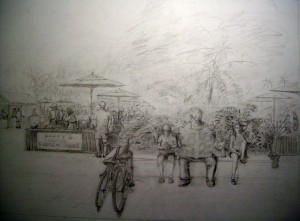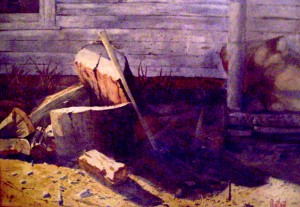
We are glad to see Mr. Burton’s return to Art Center Information after a few weeks hiatus. After he posted the previous blog discussing his work on his preliminary graphite sketch, he has finally finished the composition (at left).
He has been on the road doing art promotional work for other artists, and now we are happy to have him back and in the mood to paint. We caught up with him, and he agreed to a few questions about the future painting.
Interviewer: In the last blog post on Art Center Information’s sight, you discussed your thoughts about your next watercolor painting. Reading it, I almost felt you were more than a little anguished about it, feeling that color composition was going to make or break the painting.
Richard: It will. This is a busy scene, and it has to be well planned from a color composition standpoint. To make it work properly, I will need to dramatize the scene with dazzling sunlight and carefully placed darks.
Interviewer: You referenced that the idea for the painting was while you were on vacation in Florida. You took pictures, but did you do any paint or drawing sketches while you were there?
Richard: No. At the time, I’d just recently retired from forty years of a sales management business career, and I didn’t come up with the idea for the Art Center Information business until I took the vacation. The composition for this picture came from my head. The problem with this is that I had to create and work on the perspective of the drawing, which has two different vanishing points…very close, but definitely different because of the width of the planter division and the lanes where the booths are placed. I had to figure this one out mathematically. Had I sketched on sight, I could have done so based on what I was seeing. I now carry my watercolor sketching case practically everywhere I go. You can’t say enough about plein-air sketching.

Interviewer: You have painted many watercolor pictures. Did you begin each with such trepidation?
Richard: Yes, and the reason for this is because watercolor, unlike other mediums, is very unforgiving. This is why I feel a good watercolor should be more valuable than any other mediums. Although, I’ve been painting in acrylics, I’m glad to get back to the challenge of watercolor.
Interviewer: When you mentioned dramatizing dazzling sunlight, have you planned your color scheme?
Richard: What can I say? I want to use transparent washes. Of course, the composition as it is now sketched suggests life and activity, which the painting muat show by emphasizing the people with color. I will have to exaggerate contrast between light and shade, beginning with the darks. I can’t forget reflected light that surely would exist with such brilliance. Again, this is in my mind’s eye. I have to get out and try to capture what I see existing in nature. I can imagine it, but it is better if I can find it.
Interviewer: You mentioned you might do a color sketch for the painting using the abstract technique. Can you tell us a little more about this?
Richard: I want to capture a certain looseness in the painting. This is the reason I’m thinking of a color abstract technique. I intend to make several different color sketches using different techniques. It’s very important that I get the first wash right. Otherwise, I’m sure it will be one of those tear up and throw away situations. The important thing is that the color fuses well with other colors. My great concentration will be that when the layer is glazed on a wash that the result is a clean transparent overlay. In this case, tonal value and color density becomes critical. Much of the abstraction, as far as color is concerned, is in the background, featuring trees with different colors. I can imagine mixtures creating various tones of greens, yellows, sienna, and blues. Done properly, it could blow me off my stool. We’ll see…lots to think about.
Interviewer: Thank you for taking the time with us, and we wish you the best on your next painting.
Richard: My pleasure.
